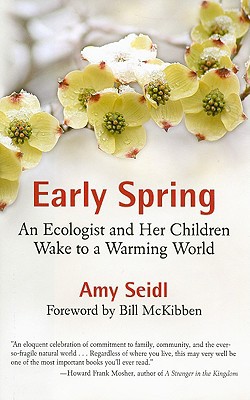

| EARLY SPRING An Ecologist and Her Children Wake to a Warming World Amy Seidl Bill McKibben (Fwd.) Boston: Beacon Press, 2009 |
Rating: 5.0 High |
|||
| ISBN-13 978-0-8070-8584-4 | ||||
| ISBN-10 0-8070-8584-7 | 173pp. | HC | $24.95 | |
A hollow in the Vermont hills is in some sense a protected enclave. The mountain walls, the stands of trees lessen the impact of storms. More important, they foster a certain isolation, a "micro-biome" apart from the hustle and bustle of civilization, where human life heeds the seasons more closely than city or suburban dwellers may.
As an ecologist, Amy Seidl has travelled the world to investigate changes in ecosystems from the tropics to Antarctica. But climate change did not come home to her heart until she began to see the changes it brought in her Vermont hollow home.
Her book is a tribute to that hollow and to the easy participation in the seasons and flows of life it permits her and her family. But it is also a warning, gently delivered, of disturbing portents. That warning is couched in terms of how many days earlier spring arrives, of which birds have arrived at or disappeared from the area, of community celebrations canceled because the ice they depend upon failed. Quotidian changes like the springtime flowering of crocuses or the appearance of the common ringlet butterfly are vividly described, sometimes as seen through the fresh eyes of her two young daughters.
"With each year I am compelled to ask: How are the natural communities and ecosystems where I live responding to climate change? What does a thunderstorm in January signal? What about deluges in May that preclude spring planting? And the absence of ice on rivers and ponds in early winter? These are examples from my landscape—and the natural and agricultural communities in it—that signal that the world around me is moving into flux. As these events collect, I realize how more and more of my observations reflect the predictions that climate scientists are making for New England—greater single precipitation events, warmer nights, shorter winters, and overall more variable weather." – Page XIII |
Like anywhere on Earth, New England has been harmed by changes in climate, perhaps most recently in 1816, the Year Without a Summer.
"A hard frost in July ruined the beans, cucumbers, and squash, and while the mix of cold and warm weather created good conditions for hardy rye and oats, a concurrent drought offset the opportunity to recoup garden losses with abundant grains. When a final killing frost hit the region on August 17, it dashed all hopes for local subsistence, and people began to import goods—mackeral from the coast and corn seed from the Carolinas—to see them through the next winter. Vermonters were desperate for foodstuffs and strapped for currency, so much so that maple sugar was made legal tender that year." – Pages 6-7 |
Such regional crises are common in recorded history, and one feature they share is their limited scope. In this case, interior New England could rely on locally caught fish and on seed stocks from states further south. The gradual warming of climate now taking place will not be so limited. It is far from certain that agriculture will benefit. Dr. Seidl foresees difficulties in Vermont.
"On one hand we may gain in pitted fruits, on the other we might lose cold-loving crucifers. Crops planted early, like corn, will do less well; in 2005 farmers planted three times before the rains finally subsided and the corn seed took. Between the increasingly erratic weather and a whole host of new fungi, pathogens and insect pests that will colonize our gardens and farms, the challenges will be enormous. It is hard to imagine that agriculture will truly benefit from the changes, especially given the predicted changes in rainfall patterns. Yet global warming will force us to respond creatively to the new dynamics and disequilibrium in our landscapes. Frankly, we can do nothing else." – Page 39 |
She writes of witnessing an invasion of one such insect, the forest tent caterpillar.1 Like many, it was formerly kept out of New England by frigid winter temperatures. No longer. An infestation may last five years, and the tools we have to fight it are imperfect. Even the biologicals she mentions2 are virtual blunderbusses, killing many valuable insects along with their intended target. She delves into the intricacies of photosynthesis, describing the differences between C3 and C4 plants.3 C3 plants benefit from greater CO2 concentrations. Unfortunately for us, the way they benefit is to build more indigestible structure and more defensive chemicals. Many of them are weeds. So we'll get expanded populations of ragweed4 (more hay fever), poison ivy (more itching) and dandelions (more unsightly lawns). The growth of C4 plants, including important grains like sorghum and corn, is not boosted by additional CO2.
The book is a useful compendium of early signs of climate change in Vermont and in the wider world, well supported with discussion and citations. (The citations are found in a Selected Bibliography and Notes, pp. 161-170.) These discussions are interspersed with personal anecdotes from the author's life, emotive and colorful but with little respect for chronological order. The whole makes an entertaining read, similar in some ways to Elisabeth Kolbert's Field Notes from a Catastrophe. It is enriched by a sense of history and an acute understanding of the high stakes involved in how we deal with climate change. Despite its intimation of the wrenching changes that may lie ahead, it ends on a hopeful note. The few errors are mostly awkwardnesses of phrasing, and the lack of an index is a trivial defect in this short volume.

 To contact Chris Winter, send email to this address.
To contact Chris Winter, send email to this address.